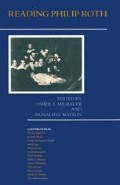Abstract
Imagine a reader reading, for the first time, Philip Roth’s My Life as a Man. She, let us say, dimly remembers reading the infamous and shocking Portnoy’s Complaint as an undergraduate, but now recalls little of the novel with the exception of the hero’s repulsive sexuality and a bizarre female character bearing the nickname of ‘The Monkey’. More recently, she has read The Ghost Writer and, enjoying the seeming lightness and brevity of that novel, has started Zuckerman Unbound. But she soon tires of Zuckerman and his exploits, so she stops reading the second instalment of the ‘Zuckerman Trilogy’ somewhere in the novel’s first third, and gives up reading Philip Roth for the moment. Then, in a bookstore, she sees that several of Roth’s novels have been reissued in attractive paperbacks by Penguin Books; she sees one entitled My Life as a Man bearing on the cover the interesting illustration of a hand holding a knife. Ignoring the usual and (to her mind) meaningless panegyrics on the back cover, she makes the assumption, given the name and title on the front cover, that this is Roth’s autobiography, a confession from (now she remembers Portnoy more fully) a parodist of confessions. She buys; she reads.
Access this chapter
Tax calculation will be finalised at checkout
Purchases are for personal use only
Preview
Unable to display preview. Download preview PDF.
Notes
Philip Roth, My Life as a Man (1974; rpt. New York: Penguin Books, 1985) front matter. All future references will be to this edition and will be noted parenthetically in the text.
Patrick O’Donnell, ‘The Disappearing Text: Philip Roth’s The Ghost Writer’, Contemporary Literature, 24 (1983) pp. 365–78.
Roth makes the distinction between Roth (the living American novelist) and ‘Roth’ (the critical fictions supposedly based on Roth) in ‘Document Dated July 27, 1969’, one of the essays in Philip Roth, Reading Myself and Others (New York: Farrar, Straus & Giroux, 1975) pp. 23–31.
The reviews of My Life as a Man were generally unsympathetic, and many of them found the novel to be as narcissistic as its protagonist, or ‘too close’ to Roth’s own life. For examples, see the reviews by J. W. Aldridge, Commentary, 58 (September 1974) p. 82,
and Morris Dickstein, New York Times Book Review, 2 June 1974, p. 1.
The reference to ‘pasteboard masks’ is, of course, to Ahab’s speech in Moby-Dick, where he articulates the desire to strike through the façade of appearances to the essential self or reality. Hermione Lee, in Philip Roth (New York: Methuen, 1982) p. 20, glosses this passage as revelatory of Roth’s own concern with versions of the constricted, social self (Ishmael), or the liberated, boundless self who may be self-destructive (Ahab).
John Ashbery, Self-Portrait in a Convex Mirror: Poems by John Ashbery (1975; rpt. New York: Penguin Books, 1976) p. 68.
Edward Said, Beginnings: Intention and Method (Baltimore, Md: Johns Hopkins University Press, 1975) p. 22.
Sigmund Freud, ‘On Narcissism: An Introduction (1914)’, in Collected Papers, trs. Joan Riviere (New York: Basic Books, 1959) vol. 4, p. 50.
Rosalind Coward and John Ellis, Language and Materialism: Developments in Semiology and the Theory of the Subject (London: Routledge & Kegan Paul, 1977) p. 110. The quote appears as part of Coward and Ellis’s discussion of the subject; here, clearly, I am indebted to their reinterpretation of the subject in psychoanalytic theory.
For some recent developments on the uses of Lacan for an understanding of narrative texts and subjects, see Robert Con Davis (ed.), Lacan and Narration: The Psychoanalytic Difference in Narrative Theory (Baltimore, Md: Johns Hopkins University Press, 1983).
David Carroll, The Subject in Question: The Languages of Theory and the Strategies of Fiction (Chicago, Ill.: University of Chicago Press, 1982) p. 116.
Editor information
Editors and Affiliations
Copyright information
© 1988 Asher Z. Milbauer and Donald G. Watson
About this chapter
Cite this chapter
O’Donnell, P. (1988). ‘None Other’: The Subject of Roth’s My Life as a Man. In: Milbauer, A.Z., Watson, D.G. (eds) Reading Philip Roth. Palgrave Macmillan, London. https://doi.org/10.1007/978-1-349-19119-2_10
Download citation
DOI: https://doi.org/10.1007/978-1-349-19119-2_10
Publisher Name: Palgrave Macmillan, London
Print ISBN: 978-1-349-19121-5
Online ISBN: 978-1-349-19119-2
eBook Packages: Palgrave Literature & Performing Arts CollectionLiterature, Cultural and Media Studies (R0)

